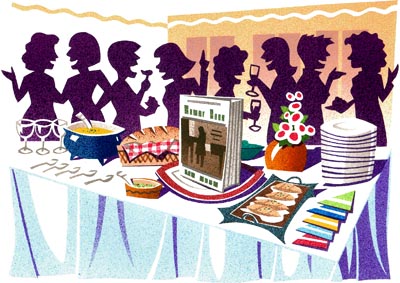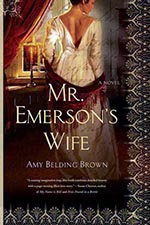Connections
Virginia Day Hayden ’42, speaking of the camaraderie that the Boston Alumnae Book Club cooks up over dinner and discussion, serves up this thought: “If good food and good company sometimes seem to de-emphasize the book, so be it. I think of us as a Bates group meeting for fellowship, with a book as our excuse, rather than as a class.”

Sharing a meal at each meeting only reinforces the family feeling at the Boston Alumnae Book Club.
Back in November 2000, six alumnae, responding to an invitation from Leigh Graham ’82, gathered at the College Club on Commonwealth Avenue to discuss a book and, in the process, possibly revive the venerable but dormant Boston Alumnae Club, the all-women’s group that had existed since the 1800s.
The key ingredient that night was a broad range of ages: two women from the Class of ’42 and one each from the classes of 1967 (this writer), 1968, 1982, and 1988. One of us had graduated with the daughter of another. Three members had spent their first year in Chase House, two living in Chase’s third-floor quad, 20 years apart. Already we felt like family.
The Boston Alumnae Book Club now has 12 to 15 regular members for our monthly meetings. “Having an average of five decades of graduates at each meeting makes for great discussions,” says Lisa Romeo ’88, our group’s current organizer and communicator.
| Club Chapters Bates’ two current reading groups, the Boston Alumnae Book Club and Cumberland County Book Club, welcome new members. Contact Lisa Romeo ’88 (Boston), or Helen Leadley Andreoli ’92 (Maine)with questions. Bates alums interested in forming a book club in their area can get advice and tips from the Office of Alumni and Parent Programs. Contact Leigh Graham ’82, assistant director, at 207-786-8255. |
Sharing a meal at each meeting only reinforces the family feeling. Most months we meet in a member’s home, but occasionally we gather at a restaurant, either to accommodate a larger group or when a book such as Tender at the Bone, by Gourmet editor-in-chief Ruth Reichl, prompts a meal out.
No one is obliged to host a meeting, and in food we aim for satisfying, not fussy. We’ve seen no competitive upping of the culinary ante that spells the end of some reading clubs. (Which is not to say we don’t enjoy special productions such as Linda Knox Large ’68’s stew-in-a-pumpkin — and appreciate her scouring local farmstands for the recipe’s requisite cheese pumpkin.) And though Marcia Putnam O’Shea ’61’s freshly baked cream puffs with vanilla ice cream and homemade fudge sauce make us think about starting and ending with dessert, we are still eager to leave the table to regroup in a conversational oval for the final course — the book discussion.
Reflecting wide-ranging interests, books come from diverse genres. The club offers both comfort and challenge, sometimes indulging established habits and sometimes testing reader tastes. Disagreements about a book’s merits characteristically result in bemusement rather than confrontation. As O’Shea says of one member with whom she sometimes disagrees, “I always love hearing [her] opinions, even though I found The Amazing Adventures of Kavalier & Clay virtually unreadable.”
An atmosphere of openness and trust leads to conversations about values. Does exposure to different cultures and viewpoints lead to breadth and tolerance? How do we respond when long-held visions of our society are challenged by exposure to other perspectives, other certainties?
While the discussion part of the meeting is decidedly not a “class,” members frequently do unassigned research. For a discussion of Matthew Pearl’s The Dante Club, one member supplemented Longfellow’s translations of the Inferno with modern ones by John Ciardi, L.H.D. ’70, and Robert Pinsky. Another member distributed biographical and literary profiles of Eudora Welty and Zora Neale Hurston when we discussed their novels.
 Author events are great treats. The meeting with Amy Belding Brown ’69, author of the historical novel Mr. Emerson’s Wife, took place, appropriately, in Concord and attracted more than 25 alums. Brown discussed the blending of historical fact and imaginative event in a genre that delights some readers interested in “story” while discomfiting others with its uncertain line between fact and fiction. With candor, she talked about the intersection of authorial intention, editorial vision, and a predicted audience response in the publication process.
Author events are great treats. The meeting with Amy Belding Brown ’69, author of the historical novel Mr. Emerson’s Wife, took place, appropriately, in Concord and attracted more than 25 alums. Brown discussed the blending of historical fact and imaginative event in a genre that delights some readers interested in “story” while discomfiting others with its uncertain line between fact and fiction. With candor, she talked about the intersection of authorial intention, editorial vision, and a predicted audience response in the publication process.
When we included Jenna Blum’s Those Who Save Us in our reading list, Lisa Romeo contacted the young writer through her Web site, inviting her to join the discussion. Blum responded enthusiastically and entranced 19 attendees from the Bates classes of 1942 to 2002 with details of how four years of interviewing Holocaust survivors for Stephen Spielberg’s Shoah Foundation contributed to her novel.
Our Bates connection brought us together and remains a strong component in the good health of the book club. “Our common Bates roots diminish the differences between us in ages and life experiences,” says Romeo. Intellectual curiosity, a love of reading, and respectful listening also contribute significantly to its continued success.
Starting out simply as members of a book club, we became friends and discovered a simple truth. As Judy Kent Patkin ’57 says, “It’s fun to read and discuss with a group of good friends.”
Holly Hagedorn Zaitchik ’67, a former managing editor of the scholarly journal Studies in Romanticism at Boston University, recently retired after 20 years teaching in the BU writing program.